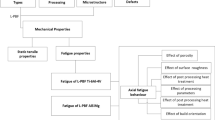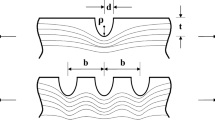Abstract
The present study investigates the effect of the high-speed milling (HSM), grinding and anodizing processes on the high cycle fatigue strength of the AA7050 aluminum alloy. These processes are systematically applied to certain aircraft components as specified by aeronautical standards, to attain a good surface finish. In order to understand the effect of each process on the fatigue strength, a vast experimental campaign consisting of fully reversed plane bending fatigue tests has been conducted on specimens with different surface states. A polished batch, three milled batches with different surface roughness, a grinded batch and two milled then anodized batches with different surface roughness have been tested. The results show that the roughness must be highly degraded (Sa > 3 \(\mu m\)) in order to impact the fatigue strength. It is also shown that anodizing has slight beneficial effect on the fatigue strength in the high cycle fatigue domain studied. The experimental results show a dependence of the fatigue strength on the surface roughness via the parameter \(\sqrt{Sa}\), previously proposed by the authors.




























Similar content being viewed by others
Availability of data and material
All data generated or analyzed during this study are included in the present article.
Code availability
Not applicable
References
Novovic D, Dewes RC, Aspinwall DK, Voice W, Bowen P (2004) The effect of machined topography and integrity on fatigue life. Int J Mach Tools Manuf 44(2–3):125–134
Brunet, S. (1991). Influence des contraintes résiduelles induites par usinage sur la tenue en fatigue des matériaux métalliques aéronautiques (Doctoral dissertation, Paris, ENSAM)
Guillemot, N. (2010). Prise en compte de l’intégrité de surface pour la prévision de la tenue en fatigue de pièces usinées en fraisage (Doctoral dissertation, École normale supérieure de Cachan-ENS Cachan)
Chaussumier M, Mabru C, Chieragatti R, Shahzad M (2013) Fatigue life model for 7050 chromic anodized aluminium alloy. Procedia Engineering 66:300–312
Quan F, Chen Z, Ye H, Cui C, Cui Y (2021) Study of the effect of surface roughness on fatigue strength of GH4169 based on indirect evaluation of the notch root radius. Int J Fatigue 152:106440
Jouini N, Revel P, Thoquenne G (2020) Influence of surface integrity on fatigue life of bearing rings finished by precision hard turning and grinding. J Manuf Process 57:444–451
Xu Z, Dunleavey J, Antar M, Hood R, Soo SL, Kucukturk G, Hyde CJ, Clare AT (2018) The influence of shot peening on the fatigue response of Ti-6Al-4V surfaces subject to different machining processes. Int J Fatigue 111:196–207
Xun L, Guan CM, Zhao P (2017) Influences of milling and grinding on machined surface roughness and fatigue behavior of GH4169 superalloy workpieces. Chin J Aeronaut 31(6):1399–1405
Liu D, Shi Y, Lin X, Xian C, Gu Z (2019) Study on avoiding the knife marks of the blade after polishing by flap disc. Int J Adv Manuf Technol 105(5):2733–2744
Ås SK, Skallerud B, Tveiten BW (2008) Surface roughness characterization for fatigue life predictions using finite element analysis. Int J Fatigue 30(12):2200–2209
Shahzad M, Chaussumier M, Chieragatti R, Mabru C, Aria FR (2010) Influence of surface treatments on fatigue life of Al 7010 alloy. J Mater Process Technol 210(13):1821–1826
Savas TP, Earthman JC (2008) Surface characterization of 7075–T73 aluminum exposed to anodizing pretreatment solutions. J Mater Eng Perform 17(5):674–681
Lee E, Jeong Y, Kim S (2012) SN Fatigue behavior of anodized 7050–T7451 produced in different electrolytes. Metall Mater Trans A 43(6):2002–2011
Mauduit, A. (2013).Comparaison OAS - OAST en termes de faïençage, corrosion, fatigue. Les rendez-vous technologiques «Les traitements de surface des alliages légers » Cetim-Certec
Paz Martínez-Viademonte M, Abrahami ST, Hack T, Burchardt M, Terryn H (2020) A review on anodizing of aerospace aluminum alloys for corrosion protection. Coatings 10(11):1106
Abroug F, Pessard E, Germain G, Morel F (2018) A probabilistic approach to study the effect of machined surface states on HCF behavior of a AA7050 alloy. Int J Fatigue 116:473–489
Gupta VK, Agnew SR (2011) Fatigue crack surface crystallography near crack initiating particle clusters in precipitation hardened legacy and modern Al-Zn-Mg-Cu alloys. Int J Fatigue 33(9):1159–1174
Nizery, E. (2015). Amorçage et propagation des fissures de fatigue dans les alliages d’aluminium 2050-T8 et 7050-T7451 (Doctoral dissertation, Lyon, INSA)
Dixon WJ, Mood AM (1948) A method for obtaining and analyzing sensitivity data. J Am Stat Assoc 43(241):109–126
ISO-12107, 2012, Metallic materials - fatigue testing - statistical planning and analysis of data, Geneva
Li JF, Zheng ZQ, Li SC, Chen WJ, Ren WD, Zhao XS (2007) Simulation study on function mechanism of some precipitates in localized corrosion of Al alloys. Corros Sci 49(6):2436–2449
Shahzad, M. (2011). Influence de la rugosité et des traitements d’anodisation sur la tenue en fatigue des alliages d’aluminium aéronautiques 2214 et 7050 (Doctoral dissertation)
Souto-Lebel, A. (2014). Rôle de l’intégrité de surface dans la tenue en fatigue d’un acier bainitique après fraisage de finition (Doctoral dissertation, Cachan: ENS Cachan)
Kitagawa H (1976) Applicability of fracture mechanics to very small cracks or the cracks in the early stage. Proc. of 2nd ICM. Cleveland 1976:627–631
Liu G, Huang C, Zhao B, Wang W, Sun S (2021) Effect of machined surface integrity on fatigue performance of metal workpiece: A review. Chinese Journal of Mechanical Engineering 34(1):1–16
Siebel E (1957) Influence of surface roughness on the fatigue strength of steels and non-ferrous alloys. Eng Dig 18:109–112
Godreau, V. (2017). Extraction des connaissances à partir des données de la surveillance de l’usinage (Doctoral dissertation, Nantes)
Franco P, Estrems M, Faura F (2008) A study of back cutting surface finish from tool errors and machine tool deviations during face milling. Int J Mach Tools Manuf 48(1):112–123
Lavernhe S, Quinsat Y, Lartigue C, Brown C (2014) Realistic simulation of surface defects in five-axis milling using the measured geometry of the tool. Int J Adv Manuf Technol 74(1):393–401
Wang P, Zhang S, Yan ZG (2017) Study on surface defects in five-axis ball-end milling of tool steel. Int J Adv Manuf Technol 89(1):599–609
Lazkano X, Aristimuño PX, Aizpuru O, Arrazola PJ (2022) Roughness maps to determine the optimum process window parameters in face milling. Int J Mech Sci 221:107191
Dong Y, Li S, Zhang Q, Li P, Jia Z, Li Y (2021) Modeling and analysis of micro surface topography from ball-end milling in a trochoidal milling mode. Micromachines 12:1203
Funding
This work was carried out within the FUI QUAUSI project (Grant n\(^{\circ }\) FR1307003R on call n\(^{\circ }\) 15) with the support of industrial (Dassault Aviation, Europe Technologie, Figeac Aéro, Mecachrome, Spring Technologie, Precise, GEBE2, CETIM) and academic partners (LSN2-IUT Carquefou).
Author information
Authors and Affiliations
Contributions
All authors contributed to the study conception and design. Material preparation and data collection were performed by F. Abroug and E. Pessard. Analysis, discussions and validation were performed by F. Abroug, E. Pessard G. Germain and F. Morel. The first draft of the manuscript was written by F. Abroug and all authors commented on previous versions of the manuscript. All authors read and approved the final manuscript.
Corresponding author
Ethics declarations
Ethics approval
Not applicable
Consent to participate
Not applicable
Consent for publication
Not applicable
Competing interests
The authors declare no competing interests.
Additional information
Publisher’s Note
Springer Nature remains neutral with regard to jurisdictional claims in published maps and institutional affiliations.
Rights and permissions
Springer Nature or its licensor holds exclusive rights to this article under a publishing agreement with the author(s) or other rightsholder(s); author self-archiving of the accepted manuscript version of this article is solely governed by the terms of such publishing agreement and applicable law.
About this article
Cite this article
Abroug, F., Pessard, E., Germain, G. et al. Effect of end milling, grinding and tartaric-sulfuric anodizing on the fatigue behavior of AA7050 alloy. Int J Adv Manuf Technol 122, 3903–3922 (2022). https://doi.org/10.1007/s00170-022-10124-3
Received:
Accepted:
Published:
Issue Date:
DOI: https://doi.org/10.1007/s00170-022-10124-3




